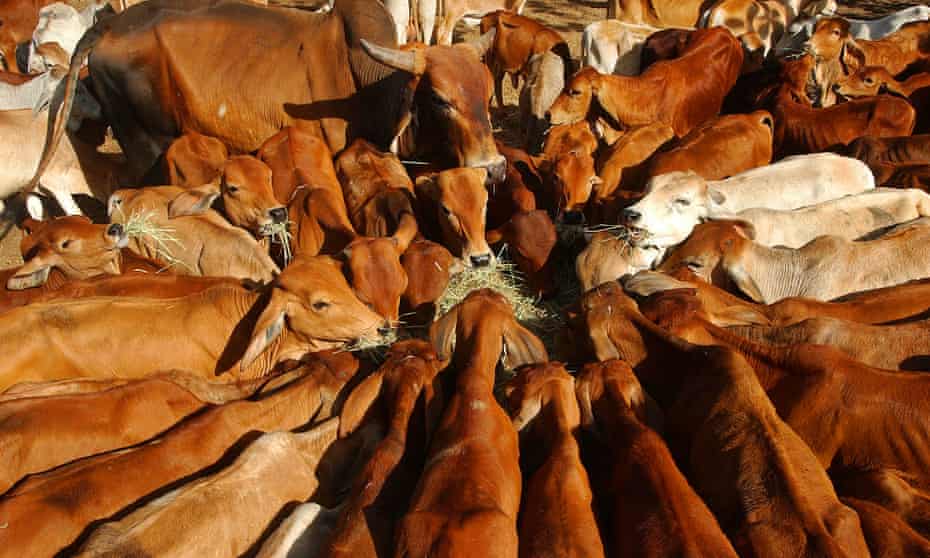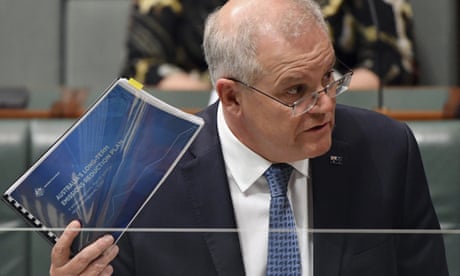Extract from The Guardian
The Morrison government released its net zero plan and Angus Taylor penned a scary piece about methane, but both lacked substance.
- Temperature Check is a weekly column examining claims about climate change made by governments, politicians, business and in the media. See the latest column and follow the series here

Last modified on Thu 28 Oct 2021 15.49 AEDT
Will cutting emissions of the potent greenhouse gas methane by a third really spark mass culls of Australian cattle, ruin the gas industry and “make life harder for everyday Australians”?
If you ask the the emissions reduction minister Angus Taylor, the answer is a resounding yes, smothered in extra scary sauce.
Writing in the Australian, Taylor says “no affordable, practical and large-scale way exists to reduce [methane from agriculture] other than by culling herd sizes”.
Cutting methane emissions by 30% by 2030 would mean “shutting down production and generation” in the gas sector, he writes.
Taylor doesn’t tell the readers of the Australian who is making the call to cut methane emissions. It’s not “activists”, as he hints, but the European Union and the United States.

The most revealing aspect of Taylor’s comment piece, though, is what he leaves out.
Australia’s meat and livestock industry accounts for about 10% of the country’s emissions, most of them coming in the form of methane produced by burping livestock.
Taylor does not mention that Meat & Livestock Australia (MLA) has a goal to reach net zero emissions across the industry by 2030. The industry says it will improve productivity, use feed supplements and increase tree planting to get there, among other steps.
Judging by Taylor’s comments, the Morrison government has suddenly lost faith in its hopes that technology will bring Australia’s greenhouse gas emissions spiralling downwards.
When the government launched its “Making Positive Energy” campaign, one of the technologies touted was a seaweed feed “that reduces the production of methane by more than 80% and has the potential to increase livestock productivity”.
As this column has covered, the government’s messaging made the supplement sound like it was already on the market, and there are some big caveats around the speed and scale of possible cuts.
But given the government is putting all its faith in technological advances to get Australia to net zero by 2050, it seems striking it should suddenly be giving off such negative energy about its own positive energy campaign.
When it comes to methane (which is the main constituent of so-called “natural” gas), Taylor has argued that capturing methane and storing it underground will keep the industry viable in a net zero future.
Now he says a modest 30% cut in methane will be ruinous for gas production.
When methane leaks from pipelines and infrastructure, this represents a loss of income for the industry, and so preventing it, according to the gas industry, would save them money.
Damien Dwyer, the deputy chief executive of the Australian Petroleum Production & Exploration Association, said earlier this year: “Minimising the loss of the product that the industry sells makes good commercial sense, ensures safety, and delivers on vital environmental objectives.”
The plan with nothing in it
The expectation for this week’s column was to look at claims made in the Morrison government’s new long-term strategy to cut greenhouse gas emissions.
But when the plan – dubbed “The Australian Way” – was announced on Monday, there was nothing actually new in it.
One thing we did learn was the government won’t take an improved emissions reduction target for 2030 to the Glasgow climate summit next week.
Instead, the government will go to Scotland only with what it thinks its emissions will be in 2030, based on its own projections.
Taylor said Australia would easily beat its current target of 26% to 28% by 2030 based on levels in 2005.
He said the projections show Australia will cut emissions by 30% by 2030, and potentially 35% if there was strong take-up of new technologies.
If the government thinks substituting a new target with projections about an old one will impress other countries at international talks, it may have to think again.
According to analysis from the Investor Group on Climate Change, the UK’s equivalent target is above 60%, the US’s is 50-51%, the European Union’s is 51%, Japan’s is 44% and Canada’s is 40%.
That’s not a tax
When Scott Morrison joined Taylor on Monday, the pair used a set of slides to sell the strategy.
Among the slides was a page that compared a “traditional approach” with “our plan”.
Under the “heading traditional approach”, the government slipped seamlessly into the political language of the Abbott-era, saying the Gillard government’s carbon pricing mechanism and the Rudd government’s attempted carbon pollution reduction scheme were examples of a “carbon tax”.
Abbott’s former chief of staff, Peta Credlin, has admitted that while the Liberal party chose to call these policies a tax, this was actually “brutal retail politics” and those Labor policies were not actually a carbon tax at all.
But Morrison’s new plan stretched this brutal politics even further, by saying previous renewable energy and clean energy targets were also examples of a carbon tax.
The “plan” says its approach will “shape” global technology trends “to our advantage” and avoid any carbon tax – ignoring how putting a price on carbon also encourages investment in lower carbon technologies.
Tim Wilson rides in
Taylor’s assistant minister, Tim Wilson, went on Channel Ten’s The Project on Tuesday night to defend The Australian Way.
“We’re using exactly the same approach as the International Energy Agency [and] the Intergovernmental Panel on Climate Change and what they’re recommending as part of the global solution, and applying it in a uniquely Australian way to Australia’s solution.”
Actually, the IEA does say carbon capture and storage will play a role in the decades ahead, but not to allow more gas projects to go ahead as Taylor has said.
The IEA says economies can reach net zero by 2050, but “beyond projects already committed as of 2021, there are no new oil and gas fields approved for development in our pathway [to net zero], and no new coalmines or mine extensions are required”.
As Morrison himself said on Tuesday: “Our plan for net zero by 2050 … will not shut down our coal or gas production or exports.”
The Australian Way to talk about climate change appears to be to creatively reinterpret the expert advice from international agencies and then name-check it.
Matt Canavan on IPCC report
On Monday morning, ABC Radio National host Fran Kelly raised with Nationals Senator Matt Canavan how extreme weather events were changing around the world, and getting worse.
On the issue of natural disasters, Canavan said: “People should read the IPCC reports. There’s no evidence yet that climate change is causing these natural disasters.”
Taking Canavan’s advice, what does the latest IPCC report say about extreme weather and the influence of rising levels of greenhouse gases in the atmosphere?
Here’s an excerpt from the summary for policymakers:
Human-induced climate change is already affecting many weather and climate extremes in every region across the globe. Evidence of observed changes in extremes such as heatwaves, heavy precipitation, droughts, and tropical cyclones, and, in particular, their attribution to human influence, has strengthened since [2013].
The report also says it is “virtually certain that hot extremes (including heatwaves) have become more frequent and more intense across most land regions since the 1950s” and that “some recent hot extremes observed over the past decade would have been extremely unlikely to occur without human influence on the climate system”.
Maybe Canavan needs to go and re-read the latest IPCC report? Here’s a handy link.
No comments:
Post a Comment